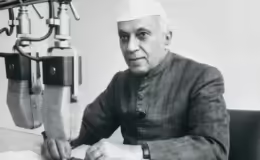Making of a New India
- By : Anirban Ganguly
- Category : Book Review

Structural reforms undertaken by the Modi regime have led the nation to the road of economic progress and the building of a welfare state
by Navneet Anand
On November 27, the Rashtrapati Bhawan Cultural Centre in New Delhi was abuzz with policy-makers and intelligentsia. The occasion was launch of the book, Making of New India: Transformation Under Modi Government, by Union Finance Minister Arun Jaitley and the handing over of the first copy to President Ram Nath Kovind. As a contributing author to this edited book, I was also present and it was a worthwhile experience.
The book containing 56 chapters was edited by Chairman of Economic Advisory Council to Prime Minister, Bibek Debroy, Dr Anirban Ganguly and Kishore Desai. Contributions were also made from many illustrious commentators and policy-makers, including Swapan Ganguly, Hardeep Singh Puri, Meenakshi Lekhi, Anil Sahasrabudhe and Bindeshwar Pathak, among others. During the launch, Debory outlined the context of the book and said that there has been a relentless attack on the Prime Minister for the “lack of reforms” and this collection by some of the finest commentators is a fine rebut to such criticisms.
On the other hand, Jaitley outlined as to how the present Government has initiated a series of socio-economic reforms that remain focused on good governance and ensure empowerment of the poor and marginalised. Referring to the many programmes, including Pradhan Mantri Ujjwala Yojana and Pradhan Mantri Awas Yojana, he said that India today sits pretty with benefits reaching to those who deserve it; unlike in the past when mindless subsidies went mostly to the undeserving.
President Kovind highlighted that this book “endeavours to elaborate on how the Government has set out to realise the vision of a New India.” Kovind also stressed as to how contemporary governance has played a vital role in giving shape and form to this all-inclusive idea of ‘New India’. “Inclusiveness” is more than just a slogan, he added further saying that “the Government has taken this philosophy to the centre of its policy-making. Numerous measures have been undertaken to ensure that socio-economic groups, communities and regions, which had so far been left behind in India’s growth story, are mainstreamed in a holistic manner. This Government has launched certain foundational programmes and made a determined attempt to decisively defeat poverty and lift the lives of millions who have hitherto not got the facilities and services they deserved.”
Giving an account of the framework of governance, the President highlighted: “The services delivered include pension and insurance schemes, electricity and cooking gas, healthcare and toilets, housing and bank accounts. At the same time, it has been seen as important to not only protect the less-privileged but also to enable and empower them. Innovative interventions such as the Pradhan Mantri Mudra Yojana and the outreach to micro, medium and small enterprises are examples of programmes that have enabled millions of individuals. They have enabled job seekers to become job creators.”
He referred to the bold measures taken by the Government against chronic challenges such as corruption and complex Government procedures. “The path has been opened for transparent, rules-based governance, cutting regulatory flab; removing unnecessary laws; and making the business environment simpler, easier and cost effective. Taken together, these efforts are helping to create an efficient and accountable governance ecosystem in the country — a trigger for fast development,” said the President.
From an economic perspective, India has emerged among the fastest growing major economies with sound macro-economic indicators. There has been a major push to infrastructure with roads, railways, airports and ports being constructed or upgraded at quick pace. Common citizens now can have access to medical insurance for their families, most of whom have access to mobile phones and banking services. While India’s relationship with the developed economic and strategic partners is strong, Foreign Direct Investment, too, have seen a rise.
The President summed up the relevance of this book saying, “With so many parts moving dynamically, it is often difficult to put all these pieces together. And to comprehend the bigger picture, it is here that the value of a book, such as the one released today, becomes clear. By weaving together an assessment of various policies and programmes, it provides its readers a multidimensional view of the national development journey. I am sure that the analysis and papers presented in the book would be helpful reference for both citizens and the Government. Citizens can benefit from the perspectives in various chapters to arrive at an informed opinion. The Government and its arms can benefit as this book provides them independent, well-researched views on things that are going right — and things that may need further attention.”
(The writer is a strategic communications professional)














